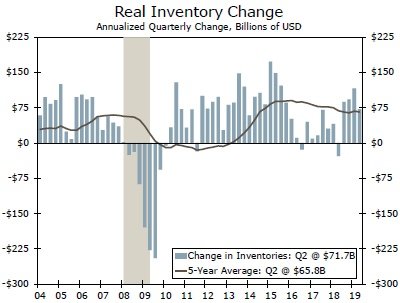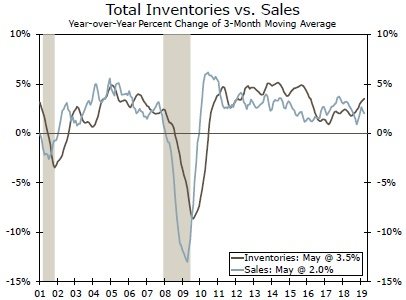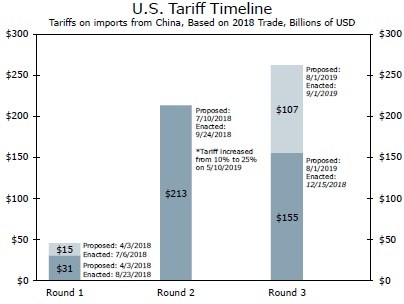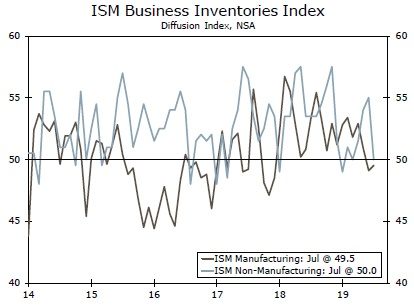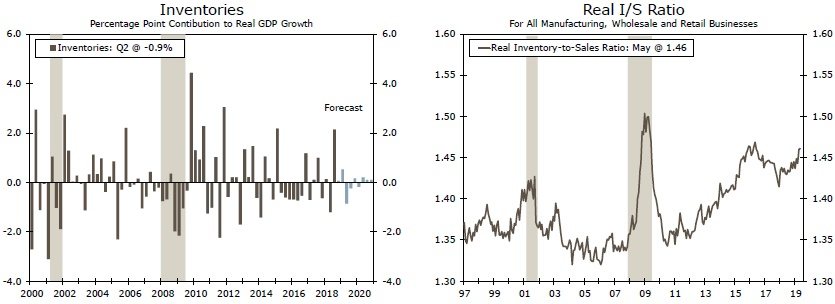Executive Summary
Golf legend Bobby Jones once said, "You swing your best when you have the fewest things to think about." Inventories play an important but choppy role in short-run variations in growth. As we gauge the swing-factor role of inventories in the second half of 2019 and beyond, we have a lot to think about, including Boeing's delivery halt, how businesses will adjust their stockpiling plans in the context of an escalating trade war and worries about late-cycle business spending dynamics and the risk of recession. Our base case is that inventories will help pull the sled for GDP growth in the second half of 2019, but we see potential for a drawdown in 2020 which could weigh on growth, perhaps substantially so.
Don't Rush Your Swing
Inventory swings can make or break a GDP report, although they are notoriously difficult to forecast. In the past four quarters, inventories have lived up to their reputation. The contribution to topline GDP growth has ranged from a boost of over two percentage points to the nearly one point drag in Q2 we warned about in our last published note on inventories (Figure 1). 1
If inventories increase unexpectedly, future production is likely to be curtailed to prevent an oversupply of goods. Conversely, a suddenly lean level of inventories would signal the need for greater output to meet demand. Fine-tuning the balance between production and sales is not easy, however, and therefore inventory growth can bounce around wildly from one quarter to the next.
Inventories' influence on GDP growth is based on how quickly stockpiles are growing (or contracting) compared with the prior quarter. When inventory growth picks up, it reflects an increase in production that was not captured in sales, i.e., produced but not consumed that quarter. Therefore a faster rate of change in inventories generates a positive contribution to GDP growth that quarter. If businesses are not adding to inventories as quickly as the prior quarter, it signals a slowdown in production not captured in final sales. Therefore even if inventory growth is positive, it can still detract from GDP growth if less positive than the prior quarter.
At a $72B annualized pace in Q2, inventory growth was closely in line with its five-year average (Figure 2). Ordinarily, that would suggest inventories are poised to fade into the background as a major influence on GDP growth over the next few quarters. After all, the recent pace of inventory growth no longer looks particularly extreme, so any deviations from last quarter's growth are likely to be small. But these are hardly ordinary times.
For one, the high value of new 737 MAX aircrafts means Boeing's issues are large enough to singlehandedly move the inventory outlook. Shipments of the company's best-selling model are likely to be suspended through at least the end of the year even as production has proceeded. While Boeing has scaled back the rate of production, any completed 737 MAX models are still ending up in inventories until they can be shipped to buyers, which means an added boost to overall inventory growth as a result. Assuming Boeing has been producing about 36 MAX planes per month, we estimate that would equate to an additional $39B annualized of inventory per quarter on its own.
Beating the Tariff Clock
Less clear is how the most recent escalation in the trade war with China may impact inventories. For a business trying to manage the uncertainty, one approach to limit tariff costs would be to get product through customs before the import taxes take effect. A second-half rush to beat the tariffs therefore could lead to stronger inventory building. Although bringing more inventory ashore sounds straightforward, a number of logistics would need to be considered, such as suppliers' production capacity, shipping capacity and where the extra goods would be stored. Cash flow and financing could be additional hurdles.
To evaluate the potential for a tariff-related inventory build before year end, it is useful to look at recent tariff episodes. Anecdotally, clients have told us that they brought in extra inventory to avoid upcoming tariffs. Recent Beige Book reports from the Federal Reserve have similarly been sprinkled with comments about some businesses trying to get ahead of tariffs. But has this been enough to move the inventory needle?
Referring back to Figure 2, one can see inventory growth ramped up over the second half of 2018 and remained exceptionally strong in the first quarter of this year. The timing coincided with the Trump administration beginning to take specific aim at China. In April 2018, tariffs on an initial $50B of imports were announced and went into effect over the summer (Round 1), while in July the situation escalated with the administration announcing 10% tariffs on about $200B of imports to go into effect in late September (Round 2). The administration also threatened that the 10% tariffs on Round 2 goods would rise to 25% at some point in the future (which occurred on May 10, 2019).
Yet the build-up in inventories over this period also coincided with a noticeable slowdown in sales (Figure 3). Arguably, wholesalers would be more directly and immediately impacted than manufacturers and retailers, particularly in sub-industries like furniture and hardware, which were exposed to tariffs under Round 2. While inventories have taken off within these sectors, the build has also come amid a slowdown in sales. (Figure 4).
The weakening sales environment suggests that the rise in inventories around the time the China tariffs kicked off was largely unintended. Indeed, while recent Beige Book reports from the Fed have included a few comments about inventories being pulled forward, they have also included plenty of comments about inventories rising due to slower sales. While some individual businesses may have hustled to get product on shore ahead of tariffs taking effect, the macro impact on inventory building is not terribly consequential, at least not yet.
Formula to Keep in Mind: Round 3 > Round 2
Might the most recent round of announced tariffs have a more meaningful impact on inventory building? This seems within the realm of possibility. First, the Trump administration has a more clearly defined track record on tariffs than it did last April when it first floated tariffs aimed specifically at China. Last summer, businesses may have had more doubts about whether the administration would follow through on implementing tariffs on such a large swath of goods, and decided bringing inventory in earlier was not worth the effort and cost. It would be reasonable for businesses to take President Trump's tariff threats more seriously now, especially with negotiations reportedly deteriorating over the past several months.
Second, the latest round of tariffs is simply bigger than past rounds. According to the Office of the U.S. Trade Representative, nearly $300B of goods are included in Round 3 versus about $200B in Round 2. By our calculations, the value of Round 3 covers closer to $260B of goods, but is nonetheless larger than prior rounds. Moreover, many of the Round 3 items will have more time to come ashore. About 60% of the Round 3 tariffs will not take effect until December 15. This gives importers 136 days to bring goods stateside, compared to 76 days for the prior round (Figure 5).
Any impact of firms racing to get ahead of upcoming tariffs, however, is likely to be at least partially offset by firms whose tariff clock has already struck midnight. Businesses whose products are already subject to 25% tariffs may try to keep inventories extra lean in the coming months in hope that a deal lifting tariffs is reached soon. More broadly, businesses may hold back on inventory building with the escalating trade tensions and recent market volatility clouding the sales outlook. The ISM surveys show manufacturers' inventories declined the past two months while inventory levels at non-manufacturers were unchanged in July (Figure 6).
Paved Roads and Good Intentions
Currently we expect inventories to have a relatively muted impact on growth in the second half of the year (Figure 7). We expect inventory growth to ease up from the $94B annualized pace averaged in H1, which brought the real inventory-to-sales ratio to a three-year high (Figure 8). However, we see the risks to this call as skewed toward the upside. We could see more inventory building and a larger contribution to GDP growth in part from a greater intended build in inventories, as companies subject to 10% tariffs beginning December 15 take efforts to stock up before the deadline. The more generalized threat of 25% tariffs on those items at some yet-to-be-determined point may give companies further incentive to load up.
A smaller, but still present risk: an unintended build in the second half if constant headlines about both tariffs on consumer products and a potential recession dent consumer confidence and subsequently sales.
Is There a Reckoning Coming in 2020?
Intended or unintended, inventories will eventually need to be right-sized with sales. That opens up the potential for a drawdown in the first half of 2020, or at the very least a slower rate of additions. Already we expect to see inventories weigh on GDP growth in the first quarter of next year as we assume Boeing resumes shipments of its 737 MAX planes, but the total drag from inventories could end up being larger if stocks pile up more before the end of the year.
The upshot is that inventories look to stay true to their role as a major swing factor in GDP growth. Rather than inventory growth settling down, we see the potential for a pickup in the second half of the year that would give a temporary boost to GDP growth. Inventories will eventually need to be unwound, however. That reckoning will likely mean a pullback in production or imports, and means inventories could be a major drag on GDP growth in 2020.
Recently, the stock market has experienced high levels of volatility. If you are thinking about participating in fast moving markets, please take the time to read the information below. Wells Fargo Investments, LLC will not be restricting trading on fast moving securities, but you should understand that there can be significant additional risks to trading in a fast market. We've tried to outline the issues so you can better understand the potential risks. If you're unsure about the risks of a fast market and how they may affect a particular trade you've considering, you may want to place your trade through a phone agent at 1-800-TRADERS. The agent can explain the difference between market and limit orders and answer any questions you may have about trading in volatile markets. Higher Margin Maintenance Requirements on Volatile Issues The wide swings in intra-day trading have also necessitated higher margin maintenance requirements for certain stocks, specifically Internet, e-commerce and high-tech issues. Due to their high volatility, some of these stocks will have an initial and a maintenance requirement of up to 70%. Stocks are added to this list daily based on market conditions. Please call 1-800-TRADERS to check whether a particular stock has a higher margin maintenance requirement. Please note: this higher margin requirement applies to both new purchases and current holdings. A change in the margin requirement for a current holding may result in a margin maintenance call on your account. Fast Markets A fast market is characterized by heavy trading and highly volatile prices. These markets are often the result of an imbalance of trade orders, for example: all "buys" and no "sells." Many kinds of events can trigger a fast market, for example a highly anticipated Initial Public Offering (IPO), an important company news announcement or an analyst recommendation. Remember, fast market conditions can affect your trades regardless of whether they are placed with an agent, over the internet or on a touch tone telephone system. In Fast Markets service response and account access times may vary due to market conditions, systems performance, and other factors. Potential Risks in a Fast Market "Real-time" Price Quotes May Not be Accurate Prices and trades move so quickly in a fast market that there can be significant price differences between the quotes you receive one moment and the next. Even "real-time quotes" can be far behind what is currently happening in the market. The size of a quote, meaning the number of shares available at a particular price, may change just as quickly. A real-time quote for a fast moving stock may be more indicative of what has already occurred in the market rather than the price you will receive. Your Execution Price and Orders Ahead In a fast market, orders are submitted to market makers and specialists at such a rapid pace, that a backlog builds up which can create significant delays. Market makers may execute orders manually or reduce size guarantees during periods of volatility. When you place a market order, your order is executed on a first-come first-serve basis. This means if there are orders ahead of yours, those orders will be executed first. The execution of orders ahead of yours can significantly affect your execution price. Your submitted market order cannot be changed or cancelled once the stock begins trading. Initial Public Offerings may be Volatile IPOs for some internet, e-commerce and high tech issues may be particularly volatile as they begin to trade in the secondary market. Customers should be aware that market orders for these new public companies are executed at the current market price, not the initial offering price. Market orders are executed fully and promptly, without regard to price and in a fast market this may result in an execution significantly different from the current price quoted for that security. Using a limit order can limit your risk of receiving an unexpected execution price. Large Orders in Fast Markets Large orders are often filled in smaller blocks. An order for 10,000 shares will sometimes be executed in two blocks of 5,000 shares each. In a fast market, when you place an order for 10,000 shares and the real-time market quote indicates there are 15,000 shares at 5, you would expect your order to execute at 5. In a fast market, with a backlog of orders, a real-time quote may not reflect the state of the market at the time your order is received by the market maker or specialist. Once the order is received, it is executed at the best prices available, depending on how many shares are offered at each price. Volatile markets may cause the market maker to reduce the size of guarantees. This could result in your large order being filled in unexpected smaller blocks and at significantly different prices. For example: an order for 10,000 shares could be filled as 2,500 shares at 5 and 7,500 shares at 10, even though you received a real-time quote indicating that 15,000 shares were available at 5. In this example, the market moved significantly from the time the "real-time" market quote was received and when the order was submitted. Online Trading and Duplicate Orders Because fast markets can cause significant delays in the execution of a trade, you may be tempted to cancel and resubmit your order. Please consider these delays before canceling or changing your market order, and then resubmitting it. There is a chance that your order may have already been executed, but due to delays at the exchange, not yet reported. When you cancel or change and then resubmit a market order in a fast market, you run the risk of having duplicate orders executed. Limit Orders Can Limit Risk A limit order establishes a "buy price" at the maximum you're willing to pay, or a "sell price" at the lowest you are willing to receive. Placing limit orders instead of market orders can reduce your risk of receiving an unexpected execution price. A limit order does not guarantee your order will be executed -" however, it does guarantee you will not pay a higher price than you expected. Telephone and Online Access During Volatile Markets During times of high market volatility, customers may experience delays with the Wells Fargo Online Brokerage web site or longer wait times when calling 1-800-TRADERS. It is possible that losses may be suffered due to difficulty in accessing accounts due to high internet traffic or extended wait times to speak to a telephone agent. Freeriding is Prohibited Freeriding is when you buy a security low and sell it high, during the same trading day, but use the proceeds of its sale to pay for the original purchase of the security. There is no prohibition against day trading, however you must avoid freeriding. To avoid freeriding, the funds for the original purchase of the security must come from a source other than the sale of the security. Freeriding violates Regulation T of the Federal Reserve Board concerning the extension of credit by the broker-dealer (Wells Fargo Investments, LLC) to its customers. The penalty requires that the customer's account be frozen for 90 days. Stop and Stop Limit Orders A stop is an order that becomes a market order once the security has traded through the stop price chosen. You are guaranteed to get an execution. For example, you place an order to buy at a stop of $50 which is above the current price of $45. If the price of the stock moves to or above the $50 stop price, the order becomes a market order and will execute at the current market price. Your trade will be executed above, below or at the $50 stop price. In a fast market, the execution price could be drastically different than the stop price. A "sell stop" is very similar. You own a stock with a current market price of $70 a share. You place a sell stop at $67. If the stock drops to $67 or less, the trade becomes a market order and your trade will be executed above, below or at the $67 stop price. In a fast market, the execution price could be drastically different than the stop price. A stop limit has two major differences from a stop order. With a stop limit, you are not guaranteed to get an execution. If you do get an execution on your trade, you are guaranteed to get your limit price or better. For example, you place an order to sell stock you own at a stop limit of $67. If the stock drops to $67 or less, the trade becomes a limit order and your trade will only be executed at $67 or better. Glossary All or None (AON) A stipulation of a buy or sell order which instructs the broker to either fill the whole order or don't fill it at all; but in the latter case, don't cancel it, as the broker would if the order were filled or killed. Day Order A buy or sell order that automatically expires if it is not executed during that trading session. Fill or Kill An order placed that must immediately be filled in its entirety or, if this is not possible, totally canceled. Good Til Canceled (GTC) An order to buy or sell which remains in effect until it is either executed or canceled (WellsTrade® accounts have set a limit of 60 days, after which we will automatically cancel the order). Immediate or Cancel An order condition that requires all or part of an order to be executed immediately. The part of the order that cannot be executed immediately is canceled. Limit Order An order to buy or sell a stated quantity of a security at a specified price or at a better price (higher for sales or lower for purchases). Maintenance Call A call from a broker demanding the deposit of cash or marginable securities to satisfy Regulation T requirements and/or the House Maintenance Requirement. This may happen when the customer's margin account balance falls below the minimum requirements due to market fluctuations or other activity. Margin Requirement Minimum amount that a client must deposit in the form of cash or eligible securities in a margin account as spelled out in Regulation T of the Federal Reserve Board. Reg. T requires a minimum of $2,000 or 50% of the purchase price of eligible securities bought on margin or 50% of the proceeds of short sales. Market Makers NASD member firms that buy and sell NASDAQ securities, at prices they display in NASDAQ, for their own account. There are currently over 500 firms that act as NASDAQ Market Makers. One of the major differences between the NASDAQ Stock Market and other major markets in the U.S. is NASDAQ's structure of competing Market Makers. Each Market Maker competes for customer order flow by displaying buy and sell quotations for a guaranteed number of shares. Once an order is received, the Market Maker will immediately purchase for or sell from its own inventory, or seek the other side of the trade until it is executed, often in a matter of seconds. Market Order An order to buy or sell a stated amount of a security at the best price available at the time the order is received in the trading marketplace. Specialists Specialist firms are those securities firms which hold seats on national securities exchanges and are charged with maintaining orderly markets in the securities in which they have exclusive franchises. They buy securities from investors who want to sell and sell when investors want to buy. Stop An order that becomes a market order once the security has traded through the designated stop price. Buy stops are entered above the current ask price. If the price moves to or above the stop price, the order becomes a market order and will be executed at the current market price. This price may be higher or lower than the stop price. Sell stops are entered below the current market price. If the price moves to or below the stop price, the order becomes a market order and will be executed at the current market price. Stop Limit An order that becomes a limit order once the security trades at the designated stop price. A stop limit order instructs a broker to buy or sell at a specific price or better, but only after a given stop price has been reached or passed. It is a combination of a stop order and a limit order. These articles are for information and education purposes only. You will need to evaluate the merits and risks associated with relying on any information provided. Although this article may provide information relating to approaches to investing or types of securities and investments you might buy or sell, Wells Fargo and its affiliates are not providing investment recommendations, advice, or endorsements. Data have been obtained from what are considered to be reliable sources; however, their accuracy, completeness, or reliability cannot be guaranteed. Wells Fargo makes no warranties and bears no liability for your use of this information. The information made available to you is not intended, and should not be construed as legal, tax, or investment advice, or a legal opinion.
Recommended Content
Editors’ Picks
EUR/USD alternates gains with losses near 1.0720 post-US PCE

The bullish tone in the Greenback motivates EUR/USD to maintain its daily range in the low 1.070s in the wake of firmer-than-estimated US inflation data measured by the PCE.
GBP/USD clings to gains just above 1.2500 on US PCE

GBP/USD keeps its uptrend unchanged and navigates the area beyond 1.2500 the figure amidst slight gains in the US Dollar following the release of US inflation tracked by the PCE.
Gold keeps its daily gains near $2,350 following US inflation

Gold prices maintain their constructive bias around $2,350 after US inflation data gauged by the PCE surpassed consensus in March and US yields trade with slight losses following recent peaks.
Bitcoin Weekly Forecast: BTC’s next breakout could propel it to $80,000 Premium

Bitcoin’s recent price consolidation could be nearing its end as technical indicators and on-chain metrics suggest a potential upward breakout. However, this move would not be straightforward and could punish impatient investors.
Week ahead – Hawkish risk as Fed and NFP on tap, Eurozone data eyed too

Fed meets on Wednesday as US inflation stays elevated. Will Friday’s jobs report bring relief or more angst for the markets? Eurozone flash GDP and CPI numbers in focus for the Euro.

